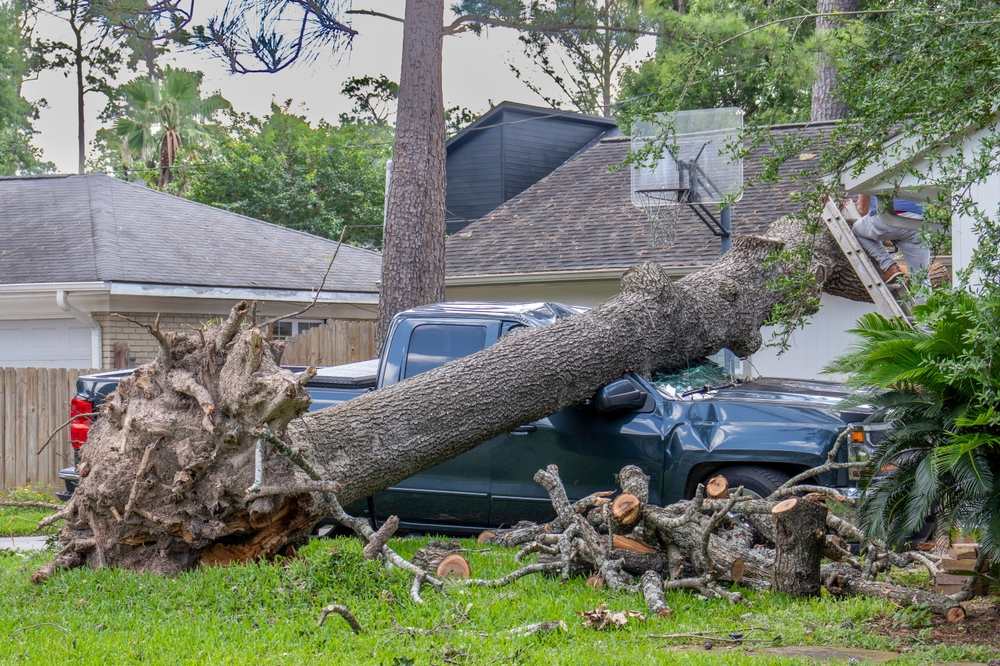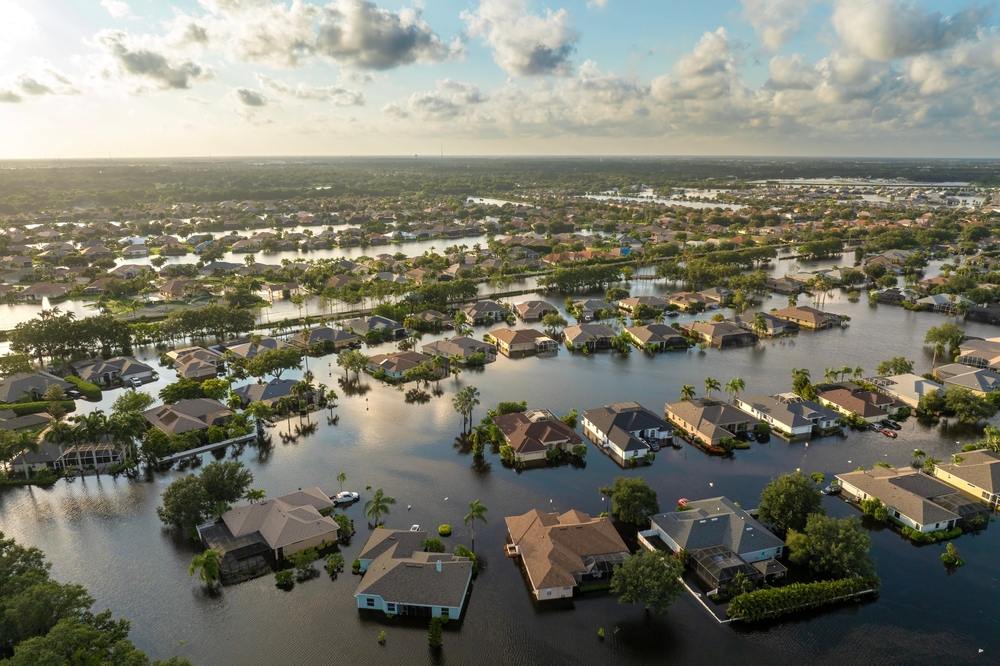TLDR:
- Hurricanes cause wind, water, and structural damage
- Category 1–5 storms bring escalating destruction
- Roofs, windows, and foundations are at high risk
- Communities face power loss, flooding, and infrastructure collapse
- Preparation reduces risks and speeds recovery
When hurricanes approach, most people think of high winds and rain. But the truth is, hurricanes bring a dangerous mix of forces that can cause a wide range of destruction. From roof failure to flooding and power outages, the effects can be catastrophic. So, what damage can a hurricane cause? This blog breaks down the type of damage hurricanes cause, how it varies by category, and how you can better understand the risk to your home and community.
Understanding Hurricane Categories
Hurricanes are measured on the Saffir-Simpson Hurricane Wind Scale, which ranks storms from Category 1 to Category 5 based on their sustained wind speeds.
Category 1 Hurricane (74–95 mph):
- Light damage to shingles, siding, and gutters
- Tree branches may break; shallow-rooted trees could topple
- Scattered power outages from downed power lines
- Minor storm surge flooding in coastal areas
Category 2 Hurricane (96–110 mph):
- Significant damage to roofs, including partial removal of coverings
- Major damage to mobile homes and poorly constructed buildings
- Extended power outages likely, lasting days or weeks
- Higher risk of storm surge and water damage to low-lying areas
Category 3 Hurricane (111–129 mph):
- Extensive structural damage, including roof decking exposed
- Trees snapped or uprooted; roads blocked
- Electricity and water may be unavailable for several days to weeks
- Serious storm surge flooding that can threaten lives and property
Category 4 Hurricane (130–156 mph):
- Severe roof failure and some structural wall collapse
- Most trees snapped or uprooted; power poles downed
- Residential areas isolated due to debris and water
- Widespread property damage with long-term utility disruptions
Category 5 Hurricane (157+ mph):
What damage can a Category 5 hurricane cause?
- Catastrophic damage: total roof and wall collapse in many homes
- Fallen trees and power poles will isolate residential areas
- Massive storm surge and inland flooding
- Areas may be uninhabitable for weeks or months
As hurricane categories increase, so does the intensity and scope of destruction. Major hurricanes—Category 3 and above—bring devastating damage and often reshape entire communities.
Structural Damage to Homes
Hurricanes can tear apart buildings, especially when combined with flying debris and structural vulnerabilities.
Common Types of Structural Damage:
- Roof Failure: Strong winds can lift shingles or even peel off entire roofs.
- Window and Door Failure: Without storm-resistant upgrades, flying debris can shatter windows and blow open doors.
- Wall Collapse: In severe cases, the force of the wind and water can cause entire walls to fail, especially in older or poorly built homes.
- Water Intrusion: Heavy rainfall and broken roofs or windows can lead to flooding and major damage inside the home.
Especially Vulnerable Structures:
- Mobile homes are at high risk even during Category 1 storms due to their lightweight construction.
- Homes with poor roof anchoring or without hurricane straps.
- Older homes that aren’t built to current building codes.
Environmental Damage and Community Impact
Beyond the home, hurricanes wreak havoc on neighborhoods, infrastructure, and the natural environment.
Types of Environmental and Community Damage:
- Downed Power Lines: Resulting in widespread power outages and potential fires.
- Flooded Streets and Homes: Storm surge can raise sea level by several feet, flooding everything in its path.
- Tree Uprooting: Strong winds can rip mature trees from the ground, causing additional damage.
- Washed-out Roads and Bridges: Transportation can be completely disrupted for days or weeks.
- Sewage and Water Contamination: Flooding can lead to unsafe drinking water and health hazards.
These damages can leave entire communities stranded or without basic services.
Secondary Hazards After the Storm
Many dangers persist even after the storm passes.
Post-Storm Risks:
- Electrical hazards from broken lines or submerged outlets
- Structural collapse during cleanup
- Mold and mildew from prolonged water exposure
- Disruption to emergency services and supply chains
Recovery can take months or even years, depending on the extent of property damage and access to resources.

What Damage Does a Hurricane Do to Different Parts of a Home?
Every part of your home can be affected differently based on wind direction, elevation, and surrounding structures.
Key Areas at Risk:
- Roof: First point of contact for sustained winds; susceptible to blow-offs and leaks.
- Windows and Doors: Vulnerable to pressure differences and debris impact.
- Foundation: At risk if heavy rainfall leads to flooding or soil erosion.
- Garage Doors: Often large and poorly reinforced, making them a weak spot for high wind entry.
A single weak point can lead to pressure buildup that damages the entire structure.
Real-World Examples of Hurricane Damage
Let’s look at what type of damage a hurricane can cause using recent storms:
- Hurricane Ian (Category 4): Caused over $112 billion in damage, including entire neighborhoods underwater from storm surge. Families returned to find only waterlogged foundations where their homes once stood, cherished memories lost beneath murky floodwaters.
- Hurricane Ida (Category 4): Brought sustained wind speeds of 150 mph and destroyed power infrastructure across Louisiana. Entire communities spent weeks in sweltering heat without power, relying on neighbors and shared meals to get through each dark, humid night.
- Hurricane Irma (Category 5): Flattened buildings in the Florida Keys and caused wide-scale roof failure and tree loss. Residents watched in disbelief as familiar streets turned to debris fields, their homes reduced to splinters in hours.
These real-world events show the range and scale of devastating damage.
Preparing for Hurricane Season
Understanding what type of damage hurricanes cause helps with planning and protection.
To prepare your home:
- Install hurricane shutters or impact-resistant windows
- Reinforce your roof and garage door
- Elevate electrical systems
- Trim trees and remove weak limbs
- Stock emergency supplies and backup power
To prepare financially:
- Review your insurance policy
- Take photos of your property for documentation
- Know your evacuation zone and shelter locations
- Being proactive can help reduce major damage and speed up recovery.
The Bottom Line
So, what damage can a hurricane really cause? From minor leaks to catastrophic destruction, the range is wide—and the risk is real. Knowing the type of damage hurricanes cause by category helps you prepare and protect your home, especially in hurricane-prone areas.
Whether you live in a mobile home or a steel-reinforced structure, hurricane preparation isn’t just wise—it’s essential. Protect your family, property, and peace of mind by taking action before the next storm strikes.
Safeguard your home and lower your insurance premium through the Hurricane Safety Program
Upgrade your roof, windows, and doors with no upfront costs, meet the latest hurricane safety standards, and lower your insurance premiums—all while protecting your family and property from high winds, flying debris, and severe weather.
